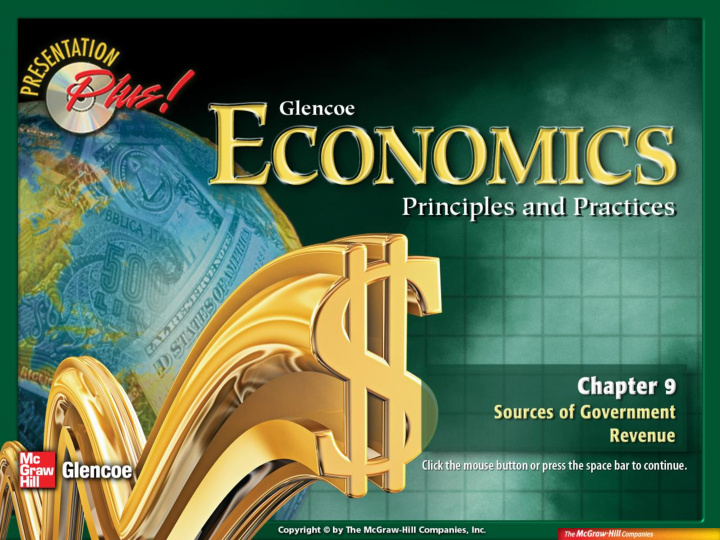



Chapter Introduction Section 1: The Economics of Taxation Section 2: Federal, State, and Local Revenue Systems Section 3: Current Tax Issues and Reforms Visual Summary
Economic Impact of Taxes (cont.) • Taxes and other governmental revenues influence the economy by affecting – Resource allocation – Behavior adjustment • Sin tax
Economic Impact of Taxes (cont.) – Productivity and growth – Determining incidence of a tax Shifting the Incidence of a Tax
Criteria for Effective Taxes (cont.) • Taxes must meet three criteria: – Equity — impartial and just: Makes sense to avoid tax loopholes – Simplicity — tax laws written so taxpayers and collectors can understand them • Individual income tax — complex tax • Sales tax — simpler
Criteria for Effective Taxes (cont.) – Efficiency — easy to administer and successful in generating revenue • Individuals file a tax return before April 15 th each year.
Two Principles of Taxation (cont.) • United States taxes are based on two principles – Benefit principle of taxation • Limitations to the benefit principle of taxation • Those who receive government services are least likely to afford them. • Benefits are hard to measure and impact others.
Two Principles of Taxation (cont.) – Ability-to-pay principle of taxation • We can’t always measure benefits derived from government spending. • Assumes individuals taxed more suffer less discomfort paying taxes
Three Types of Taxes (cont.) • Three general types of taxes exist in the United States today. – Proportional tax • If the percentage tax rate is constant, the average tax rate is constant. • Medicare tax fund Three Types of Taxes
Three Types of Taxes (cont.) – Progressive tax • Marginal tax rate – Regressive tax Profiles in Economics: Monica Garcia Pleiman
Federal, State, and Local Revenue Systems • The Internal Revenue Service (IRS) is the branch of the U.S. Treasury Department in charge of collecting taxes today.
Federal Government Revenue Sources (cont.) • Four largest sources of government revenue are – Individual income taxes • Tax is mostly collected through a payroll withholding system . • Tax code takes into account indexing . Federal Government Revenue Sources
Federal Government Revenue Sources (cont.) – FICA or Federal Insurance Contributions Act tax • Social Security and Medicare are part of payroll taxes . – Borrowing by selling bonds to investors – Corporate income tax – Excise tax The Global Economy & YOU Total Tax Revenue as a Percentage of GDP
Federal Government Revenue Sources (cont.) – Estate tax and gift tax – Customs duty – Miscellaneous fees like a user fee
State Government Revenue Sources (cont.) • Largest sources of state governments revenue – Intergovernmental revenue – Sales tax implemented by most states – Individual income taxes by most states – Other revenue sources State and Local Government Revenue Sources
Local Government Revenue Sources (cont.) • Largest sources of local governments revenue – Intergovernmental transfers from state and federal governments – Property tax • Tax assessor determines valuations of property State and Local Taxes as a Percentage of State Income
Local Government Revenue Sources (cont.) – Utility revenues from natural monopolies – Sales tax – Other revenue sources
Examining Your Paycheck (cont.) • The payroll withholding statement attached to your paycheck lists deductions taken. Biweekly Paycheck and Withholding Statement
Tax Reform (cont.) • The Economic Recovery Tax Act, signed by Ronald Reagan in 1981, included large tax reductions for individuals and businesses. • Businesses also got tax relief from accelerated depreciation and investment tax credit . Tax Table for Single Individuals, 2006
Tax Reform (cont.) • In 1983 the alternative minimum tax was passed. • In 1993 government added tax brackets in order to balance the budget. • The Taxpayer Relief Act of 1997 was both economical and political. – Capital gains tax was reduced. Total Government Receipts per Capita, Adjusted for Inflation
Tax Reform (cont.) • Temporary tax reform in 2001 — based on the federal government collecting more taxes than it was spending • Temporary tax reform in 2003 — due to slow economic growth, accelerated many of 2001 reforms • If the present trend of government spending more than it collects in taxes continues, it will be difficult to preserve tax cuts due to expire in 2011.
Alternative Tax Approaches (cont.) • Two alternative forms of taxation – Flat tax – Value-added tax (VAT) The Value-Added Tax
Alternative Tax Approaches (cont.) • Advantages to the flat tax – Simplicity to taxpayer – Closes most loopholes – Reduces need for many workers in IRS and tax preparers
Alternative Tax Approaches (cont.) • Disadvantages to the flat tax – Removes many incentives built into current tax code – Don’t know what rate is needed to replace revenues collected today – Unsure if flat tax would stimulate economic growth
Alternative Tax Approaches (cont.) • Advantages to the VAT – Tax is hard to avoid – Tax incidence is widespread – Easy to collect – Encourages saving
Alternative Tax Approaches (cont.) • Disadvantage to the VAT – Virtually invisible — other factors can change the product’s price. • Desires to simplify the tax code, unexpected expenditures on war and natural disasters, and political change all result in tax reform.
Recommend
More recommend